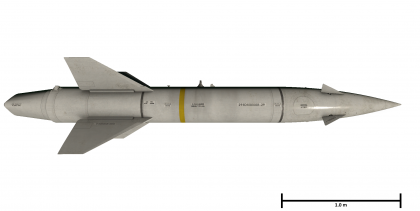AGM-12B Bullpup
| This page is about the air-to-ground missile AGM-12B Bullpup. For the other version, see AGM-12C Bullpup. |
Contents
Description
The AGM-12B Bullpup is an American manually-guided air-to-ground missile. It was introduced in Update 1.85 "Supersonic".
The AGM-12B, also known as ASM-N-7a, was created in 1960 as an upgrade from the test series ASM-N-7 and was named officially as AGM-12B in 1962. The AGM was powered by a Thiokol LR58-RM-4 liquid propellant motor to produce a range of up to 11 km and produced a thrust of 12,000 pounds or 53 Kn. The production of AGM-12B ended in 1970 and 22,000 were produced.
Vehicles equipped with this weapon
| Vehicles equipped with this weapon | |
|---|---|
| Jet fighters | F-4C Phantom II · F-8E · ␗F-104G · Scimitar F Mk.1 · Sea Vixen F.A.W. Mk.2 |
| F-5 | F-5A · ␗F-5A · F-5C |
| F-100 | ␗F-100A · F-100D |
| Strike aircraft | FJ-4B VMF-232 · F-105D |
| A-4 | A-4B · A-4E Early |
| Buccaneer | Buccaneer S.1 · Buccaneer S.2 |
| Attack helicopters | H-34 |
General info
| Missile characteristics | |
|---|---|
| Mass | 259 kg |
| Guidance | Manual (MCLOS) |
| Maximum speed | 455 m/s |
| Missile guidance time | 30 secs |
| Firing range | 8 km |
| Explosive mass | 58.05 kg TNTeq |
| Armour penetration | 92 mm |
Effective damage
Describe the type of damage produced by this type of missile (high explosive, splash damage, etc)
Comparison with analogues
Give a comparative description of missiles that have firepower equal to this weapon.
Usage in battles
Describe situations when you would utilise this missile in-game (vehicle, pillbox, base, etc)
Pros and cons
Pros:
- Large radius of destruction
- Long range
Cons:
- Hard to control
- Hard to keep track of the missile at long range
- Heavy missile that will deteriorate your flight performance
History
Development of the AGM-12 Bullpup began in the early 1950s, after the Korean War sparked a demand for more precise, guided, weapon systems that could hit targets which were usually more difficult to hit with conventional ordnance. Apart from that, the new weapon system ought to increase the safety of ground attack aircraft and their crews by keeping them further away from returning ground fire.
A competition was ran by the U.S. Navy and the Martin company was awarded a contract in 1954. Work on the new missile, designated ASM-N-7, began and after several years of development and testing, the new weapon system entered service with the Navy in April 1959.
The design of the American first air-to-ground missile was fairly simple - a 250lb (113 kg) warhead derived from an aerial bomb, mounted on a rocket-propelled, roll-stabilized body. The entire missile was manually guided via radio signal to its target, using direct vision. To aid with aiming, two bright flares would ignite on the missile's rear end upon launch. These would make it easier for the operator to keep track of the missile in flight as it would be more visible.
The Bullpup was first employed in combat during the Vietnam War, although only seeing limited success. This was due to the fact that in order to ensure the highest probability of a successful hit, the aircraft that launched the missile had to fly the same course as the missile until impact. This of course, exposed the aircraft to anti-air fire and severely limited the pilot/operator's situational awareness in the case of single-seat aircraft.
Nonetheless, the Bullpup was still mass-produced for both the U.S. Navy and Army, resulting in around 30,000 units made across all of the weapon's variants. Although the missile was starting to be replaced in the '70s by more advanced systems, it wasn't until the '80s when the Bullpup was finally retired from active service.
- From Devblog
Media
Excellent additions to the article would be video guides, screenshots from the game, and photos.
See also
- Related development
External links




